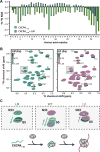Structural basis for chemokine recognition by a G protein-coupled receptor and implications for receptor activation
- PMID: 28325822
- PMCID: PMC5648539
- DOI: 10.1126/scisignal.aah5756
Structural basis for chemokine recognition by a G protein-coupled receptor and implications for receptor activation
Abstract
Chemokines orchestrate cell migration for development, immune surveillance, and disease by binding to cell surface heterotrimeric guanine nucleotide-binding protein (G protein)-coupled receptors (GPCRs). The array of interactions between the nearly 50 chemokines and their 20 GPCR targets generates an extensive signaling network to which promiscuity and biased agonism add further complexity. The receptor CXCR4 recognizes both monomeric and dimeric forms of the chemokine CXCL12, which is a distinct example of ligand bias in the chemokine family. We demonstrated that a constitutively monomeric CXCL12 variant reproduced the G protein-dependent and β-arrestin-dependent responses that are associated with normal CXCR4 signaling and lead to cell migration. In addition, monomeric CXCL12 made specific contacts with CXCR4 that are not present in the structure of the receptor in complex with a dimeric form of CXCL12, a biased agonist that stimulates only G protein-dependent signaling. We produced an experimentally validated model of an agonist-bound chemokine receptor that merged a nuclear magnetic resonance-based structure of monomeric CXCL12 bound to the amino terminus of CXCR4 with a crystal structure of the transmembrane domains of CXCR4. The large CXCL12:CXCR4 protein-protein interface revealed by this structure identified previously uncharacterized functional interactions that fall outside of the classical "two-site model" for chemokine-receptor recognition. Our model suggests a mechanistic hypothesis for how interactions on the extracellular face of the receptor may stimulate the conformational changes required for chemokine receptor-mediated signal transduction.
Copyright © 2017, American Association for the Advancement of Science.
Conflict of interest statement
Figures







Similar articles
-
Interaction of chemokine receptor CXCR4 in monomeric and dimeric state with its endogenous ligand CXCL12: coarse-grained simulations identify differences.J Biomol Struct Dyn. 2017 Feb;35(2):399-412. doi: 10.1080/07391102.2016.1145142. Epub 2016 Jul 11. J Biomol Struct Dyn. 2017. PMID: 26813575
-
Differential activity and selectivity of N-terminal modified CXCL12 chemokines at the CXCR4 and ACKR3 receptors.J Leukoc Biol. 2020 Jun;107(6):1123-1135. doi: 10.1002/JLB.2MA0320-383RR. Epub 2020 May 6. J Leukoc Biol. 2020. PMID: 32374043 Free PMC article.
-
Signal transmission through the CXC chemokine receptor 4 (CXCR4) transmembrane helices.Proc Natl Acad Sci U S A. 2016 Aug 30;113(35):9928-33. doi: 10.1073/pnas.1601278113. Epub 2016 Aug 19. Proc Natl Acad Sci U S A. 2016. PMID: 27543332 Free PMC article.
-
The good and bad faces of the CXCR4 chemokine receptor.Int J Biochem Cell Biol. 2018 Feb;95:121-131. doi: 10.1016/j.biocel.2017.12.018. Epub 2017 Dec 27. Int J Biochem Cell Biol. 2018. PMID: 29288743 Review.
-
Biological/pathological functions of the CXCL12/CXCR4/CXCR7 axes in the pathogenesis of bladder cancer.Int J Clin Oncol. 2017 Dec;22(6):991-1000. doi: 10.1007/s10147-017-1187-x. Epub 2017 Oct 11. Int J Clin Oncol. 2017. PMID: 29022185 Review.
Cited by
-
Structure-function guided modeling of chemokine-GPCR specificity for the chemokine XCL1 and its receptor XCR1.Sci Signal. 2019 Sep 3;12(597):eaat4128. doi: 10.1126/scisignal.aat4128. Sci Signal. 2019. PMID: 31481523 Free PMC article.
-
Kinetics of CXCL12 binding to atypical chemokine receptor 3 reveal a role for the receptor N terminus in chemokine binding.Sci Signal. 2019 Sep 10;12(598):eaaw3657. doi: 10.1126/scisignal.aaw3657. Sci Signal. 2019. PMID: 31506383 Free PMC article.
-
Effects of cognate, non-cognate and synthetic CXCR4 and ACKR3 ligands on human lung endothelial cell barrier function.PLoS One. 2017 Nov 10;12(11):e0187949. doi: 10.1371/journal.pone.0187949. eCollection 2017. PLoS One. 2017. PMID: 29125867 Free PMC article.
-
The solution structure of monomeric CCL5 in complex with a doubly sulfated N-terminal segment of CCR5.FEBS J. 2018 Jun;285(11):1988-2003. doi: 10.1111/febs.14460. Epub 2018 Apr 20. FEBS J. 2018. PMID: 29619777 Free PMC article.
-
Regulation of Chemokine Function: The Roles of GAG-Binding and Post-Translational Nitration.Int J Mol Sci. 2017 Aug 3;18(8):1692. doi: 10.3390/ijms18081692. Int J Mol Sci. 2017. PMID: 28771176 Free PMC article. Review.
References
-
- Ohnishi Y, Senda T, Nandhagopal N, Sugimoto K, Shioda T, Nagal Y, Mitsui Y. Crystal structure of recombinant native SDF-1α with additional mutagenesis studies: An attempt at a more comprehensive interpretation of accumulated structure-activity relationship data. J Interferon Cytokine Res. 2000;20:691–700. - PubMed
MeSH terms
Substances
Grants and funding
LinkOut - more resources
Full Text Sources
Other Literature Sources

